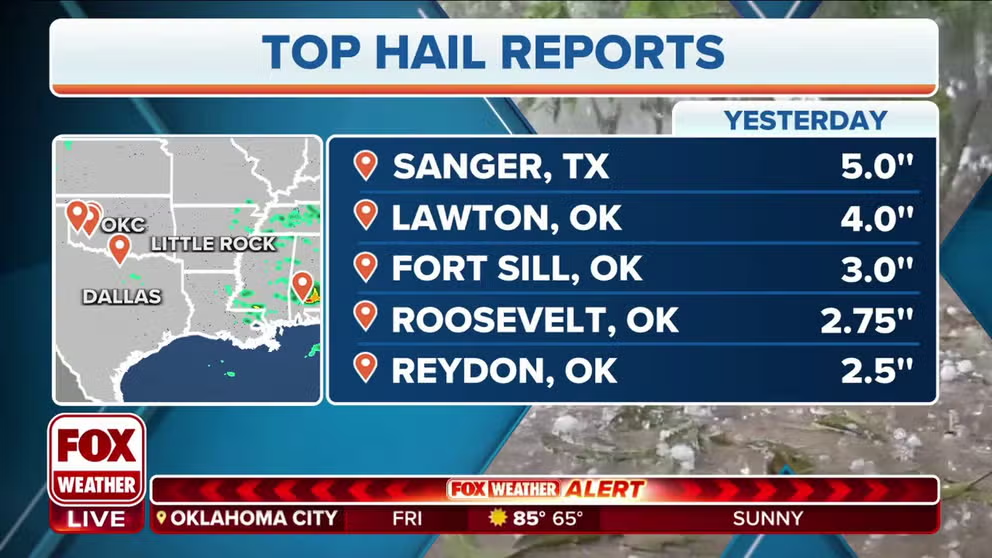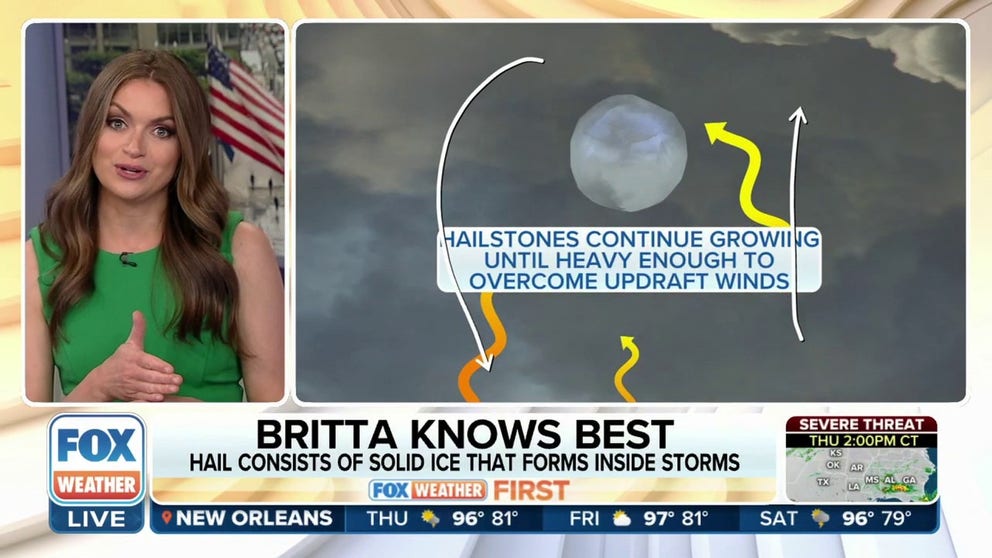What's behind all the giant hail that has pelted the South?
The National Weather Service in Jackson, Mississippi, said hail that fell on Wednesday likely was the largest in the state’s history, measuring at least 5 inches in diameter.
Days of giant hail impact Plains, southern US
Hailstones of at least five inches in diameter were reported across the South during the week of severe weather.
Significant storms across the South this week have produced an array of severe weather with tornadoes and wind damage reported across the region but hail likely cemented itself into the history books.
The FOX Forecast Center said that for five straight days, hail that measured at least 4 inches in diameter, which is unusually large for the South in June, fell over communities in Oklahoma, Georgia, Mississippi and Texas.
Local National Weather Service offices issue Severe Thunderstorm Warnings when hail the size of a quarter, or an inch in diameter, is anticipated, but these storms crushed even what is typically considered sizable.
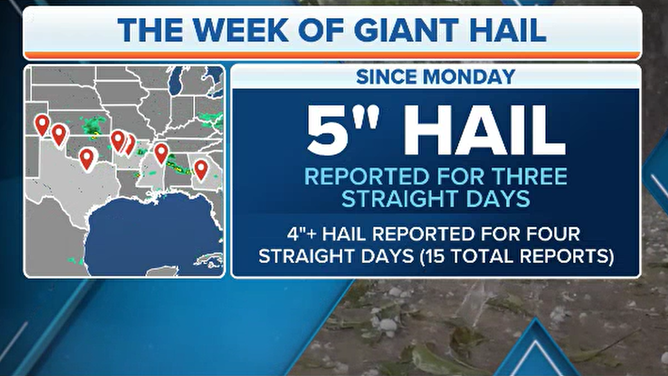
Giant hail reports
Storms on Sunday produced hail larger than 4 inches in diameter, which is roughly the size of a softball, in Denton County, Texas, on the north side of the Dallas-Fort Worth metroplex. Damage to cars and homes was reported, but there were no accounts of any significant injuries.
On Monday, the Lone Star State was once again the target of large hail. This time the giant stones fell in Burleson, on the south side of Fort Worth. Asides from golf-ball-size hail, stones at least 4 inches in diameter were also reported.
Tuesday brought more of the same, with a storm chaser witnessing iPhone-sized hail in Shamrock, Texas.
"We saw a decent number of stones ranging between 2 to 3 inches – many of which were shattered," said Jana Houser, a meteorologist and storm chaser. "As we looked a little more, we found a few that were about 4 inches, but then found this one."
The largest hail reports Wednesday shifted eastward, with a hailstone estimated to be around 5 inches in diameter that fell in Brooksville, Mississippi. That's roughly the size of a grapefruit.
After an investigation, a team of meteorologists and climatologists determined the hail was the second-largest in the state's history and measured around 4.88".
"While not a state record it is the second-largest recorded hailstone for Mississippi and very unusual for mid-June. In fact, this stone was nearly 2 inches larger than the previous June record of 3.00 inches," the state's climatologist said.

Massive hail fell around Brooksville, Mississippi on Wednesday afternoon.
(Dianne Pruitt / FOX Weather)
On Thursday, hailstones at least 5 inches in diameter were reported in Sanger, Texas. Venessa Henderson took a picture of the hail in Sanger said her hailstone wasn't even the biggest and said she saw photos of hail that could have been about 6 inches in diameter.

Large hail fell over Sanger, Texas on 6/15/2023
(Venessa Henderson / FOX Weather)
Southern Georgia saw hail about 4 inches in diameter Thursday. The softball-sized hailstone in the Peach State was the first time in June that such a sizable chunk had been witnessed and the only fifteenth occasion that a hailstone that measured 4 inches or larger had been reported. According to a NOAA database, the last time Georgia saw hail that measured 4 inches or larger was in 2011, along the Tennessee-Georgia border.
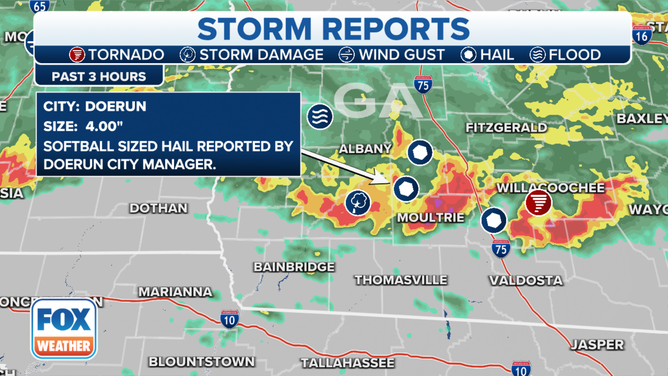
Georgia hail report
(FOX Weather)
Why all the large hail?
The FOX Forecast Center said an unusually strong subtropical jet stream in combination with a flow from a massive upper-level low over the Great Lakes and plenty of moisture were the root causes for the event.
"It was very anomalous," an official at the National Weather Service said. "This was not something that we see regularly throughout the summer."
Meteorologists at the NWS also said lapse rates, or the amount of temperature change through the lower levels of the atmosphere, were off the charts with massive temperature drops, causing more unstable air.
Impressive days of hail from severe thunderstorms
Here's what led to the large ice stones this week during the severe weather over the South.
WHY DOES THE SKY SOMETIMES TURN GREEN DURING THUNDERSTORMS?
Hail forms when raindrops become suspended in updrafts. The ice chunks typically start off as the size of peas and dimes but grow as they are suspended in the thunderstorm cloud. When the hailstone grows to a size that the updraft can no longer support, it falls towards the ground.
The largest hailstone ever reported in the U.S. fell in Vivian, South Dakota, on July 23, 2010. NOAA reported the ice chunk was 8 inches wide and weighed nearly 2 pounds.
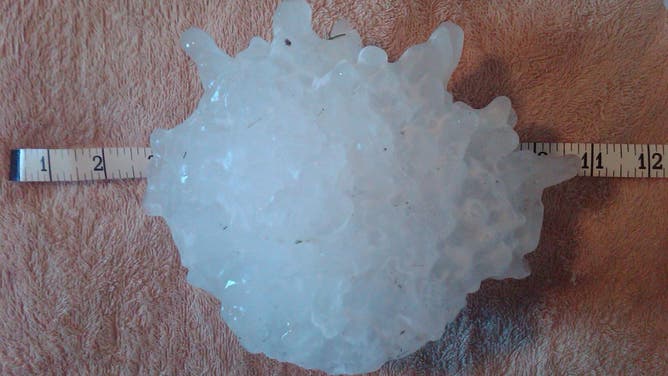
The largest hailstone ever reported in the country fell in Vivian, South Dakota, on July 23, 2010.
(NWS / FOX Weather)
According to the FOX Forecast Center, this week was the first time on record that 5-inch hail or larger had been reported for three consecutive days.
